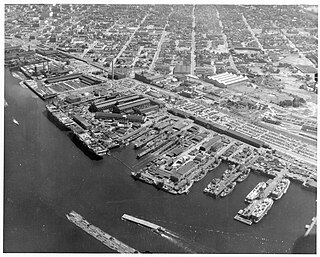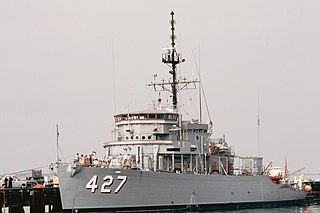
USS Admirable (AM-136) was the lead ship of her class of minesweeper built for the United States Navy during World War II. In commission from 1943 to 1945, she was transferred to the Soviet Navy in 1945 and served as T-331 until stricken in 1958.
Puget Sound Bridge and Dredging Company was a major shipbuilding and construction company, located in Seattle, Washington, on the southwestern corner of Harbor Island, an artificial island in Elliott Bay. The Bridge and Dredging Company created the island, completing its construction in 1909. It established itself in 1898 and engaged in construction projects around the United States and shipbuilding for the U.S. Navy during and after World War II. During the war it also operated under the name Associated Shipbuilders in a joint venture with the nearby Lake Union Dry Dock Company. In 1959 Lockheed purchased the shipyard and it became the Lockheed Shipbuilding and Construction Company. The Yard was permanently closed in 1987.

USS Ampere (PCE-919/AM-359/YDG-11/ADG-11) was originally planned as a PCE-905-class patrol craft for the United States Navy, PCE-919, and laid down as an Admirable-class minesweeper, named Drake, for the male duck. Before she was commissioned, her name was cancelled and she was reclassified as a District Degaussing Vessel. She was later renamed Ampere, after the ampere, a unit of electric current, which takes its name from the French physicist André-Marie Ampère.

The Auk class were a class of minesweepers serving with the United States Navy and the Royal Navy during the Second World War. In total, there were 93 Auks built.
USS Augury (AM-149) was an Admirable-class minesweeper built for the United States Navy during World War II and in commission from 1943 to 1945. In 1945, she was transferred to the Soviet Navy, in which she served as T-334.

USS Disdain (AM-222) was an Admirable-class minesweeper built for the United States Navy during World War II and in commission from 1944 to 1945. She was transferred to the Soviet Union in 1945 and after that served in the Soviet Navy as T-271.
USS Penetrate (AM-271) was an Admirable-class minesweeper built for the United States Navy during World War II and in commission from 1944 to 1945. In 1945, she was transferred to the Soviet Union and after that served in the Soviet Navy as T-280. The Soviets converted her into a naval trawler in 1948 and renamed her Taifun.

The Seattle-Tacoma Shipbuilding Corporation was an American corporation which built escort carriers, destroyers, cargo ships and auxiliaries for the United States Navy and merchant marine during World War II in two yards in Puget Sound, Washington. It was the largest producer of destroyers (45) on the West Coast and the largest producer of escort carriers of various classes (56) of any United States yard active during World War II.

Willamette Iron Works was a general foundry and machine business established in 1865 in Portland, Oregon, originally specializing in the manufacture of steamboat boilers and engines. In 1904, the company changed its name to Willamette Iron and Steel Works, under which name it operated continually until its close in 1990.
The Pusey and Jones Corporation was a major shipbuilder and industrial-equipment manufacturer. Based in Wilmington, Delaware, it operated from 1848 to 1959.

The Alco 539T was a diesel prime mover built by the American Locomotive Company. This engine was also used as a stationary powerplant, used in pipeline pumping stations, tugboats and dredges. It has a straight-six, four-stroke design in a cast block which produced from 810 to 1,000 horsepower. The engine has a bore of 12.5 inches (318 mm), and a stroke of 13 inches (330 mm). The 539 engine was built at Alco's Auburn, New York engine plant and later starting in September 1949 in Canada. The 539T was equipped with the Buchi turbocharger, being made under license by the Elliott Manufacturing Company of Jeannette, Pennsylvania. The first 539T engines were used in S-2 switchers and DL-105 passenger locomotives built in September 1940. Alco locomotives using this engine include the S-2, S-4, RS-1, RSC-1, RSD-1, DL-105, DL-107, DL-108, DL-109, and DL-110. MLW locomotives using this engine include the S-2, S-4, S-7, S-12, RS-1, and RSC-13.

Winslow Marine Railway and Shipbuilding Company was a shipyard in Puget Sound that operated from 1903 until 1959 on Bainbridge Island, Washington, United States.

General Engineering & Dry Dock Company was a shipbuilding and ship repair company in Alameda, California that was active from the 1920s through the 1940s. The company built ships for the Southern Pacific Railroad and the United States Coast Guard in the late 1920s and early 1930s and took part in the World War II shipbuilding boom, making diesel-propelled steel hulled auxiliaries for the United States Navy, primarily oceangoing minesweepers.

The PC-461-class submarine chasers were a class of 343 submarine chasers constructed mainly for the US Navy and built from 1941 to 1944. The PC-461s were based primarily on two experimental submarine chasers, PC-451 and PC-452. While PC-461 began the series, the first of the class to enter service was PC-471. As part of the Lend-Lease program, 46 ships of this class were transferred to allies of the United States. Fifty-nine PC-461s were converted to other types of patrol vessels. Eight vessels of this class were lost, and one vessel was lost after conversion to a PGM-9-class motor gunboat. Only one of the class, USS PC-566 commanded by Lieutenant Commander Herbert G. Claudius, actually sank a submarine, U-166, during World War II; however, the website 'Patrol Craft Sailors Association' cites PC-461-class ships sinking or assisting sinking up to 6 German and Japanese subs.

The Type V ship is a United States Maritime Commission (MARCOM) designation for World War II tugboats. Type V was used in World War II, Korean War, and the Vietnam War. Type V ships were used to move ships and barges. Type V tugboats were made of either steel or wood hulls. There were four types of tugboats ordered for World War II. The largest type V design was the sea worthy 186-foot (57 m) long steel hull, V4-M-A1. The V4-M-A1 design was used by a number of manufacturers; a total of 49 were built. A smaller steel hull tugboat was the 94-foot (29 m) V2-ME-A1; 26 were built. The largest wooden hull was the 148-foot (45 m) V3-S-AH2, of which 14 were built. The smaller wooden hull was the 58-foot (18 m) V2-M-AL1, which 35 were built. Most V2-M-AL1 tugboats were sent to the United Kingdom for the war efforts under the lend-lease act. The Type V tugs served across the globe during World War II including: Pacific War, European theatre, and in the United States. SS Farallon, and other Type V tugs, were used to help built Normandy ports, including Mulberry harbour, on D-Day, 6 June 1944, and made nine round trips to Normandy to deliver Phoenix breakwaters.

Fulton Shipyard was a shipbuilding company in Antioch, California. The shipyard was founded in 1924 by Frank Fulton and Angeline Fulton Fredericks. To support the World War II demand for ships, Fulton Shipyard built minesweepers, tugboats, and troopships. The shipyard was located on the Stockton Channel at 701 Fulton Shipyard Rd, Antioch, near Antioch pier and the Antioch Dunes National Wildlife Refuge. The site was the former Jarvis Brothers, opened in 1918, then Laurtzen shipyard. In 1977 the site became the California Corporation. The shipyard closed in 1999 and the land is owned by the Fulton Family Trust. Fulton Shipyard was on the San Joaquin River and an inland port located more than seventy nautical miles from the ocean, emptying into Suisun Bay. Fulton Shipyard was featured in a 1914 movie called The Stolen Yacht, a short drama film released on November 5, 1914. Frank Fulton and Angeline's son James Lloyd Fulton became an operator of a Fulton Shipyard tugboat.

South Coast Shipyard was a shipbuilding company in Newport, California. To support the World War II demand for ships South Coast Shipyard built: minesweepers, Torpedo Boats, Submarine chasers, & Air-sea rescue boats. South Coast Shipyard was opened in 1938 by Walton Hubbard. After World War II the shipyard continued to build ships for the US Navy till 1955. The shipyard was located at 2300 Newport Boulevard, Newport, California. The shipyard closed in 1963.

W. F. Stone & Son or Stone Boat Yard was a small wooden shipbuilding company in Alameda, California. To support the World War 2 demand for ships W. F. Stone & Son built tugboats, sub chasers and minesweepers. For World War 1 the shipyard, then called W. F. Stone & Son at Kennedy and Bocimer Streets, built tugboats for postwar work in 1921. The shipyard was opened in 1853 by William F. Stone, from Dartmouth, England, at the Hunter's Point in San Francisco Bay, near the current Hunters Point Naval Shipyard. In 1892 William Stone's son, Frank, ran the company and moved the shipyard to Tiburon. In 1899 he moved the shipyard again to Harbor View, San Francisco. In 1911, he again moved to Diesel Way, in Oakland, near Union Point Park on the Tidal Canal. When Lester Stone, Frank's son, became a partner, the company was changed to W. F. Stone & Son. In 1923, Frank Stone died, Lester Stone continued the company. In 1942 the company moved again, to 2517 Blanding Ave, Alameda on the south side of the Tidal Canal. In 1970 Lester Stone retired and sold the shipyard to John Whitset. Whitset, who did not rename the company, the company went into bankruptcy in 1986. It came out of bankruptcy and was sold to Bill and Grace Bodle. Bodle sold the company in 2000 to David Olson. The shipyard closed in 2004. For most of its history, the shipyard built a large variety of schooners, fishing boats, cargo ships, tugboats, sailboats, racing and recreational yachts.

Lynch Shipbuilding was a wooden shipbuilding company in San Diego, California. To support the World War II demand for ships, Lynch Shipbuilding built US Navy rescue tugs and coastal cargo ships. Lynch Shipbuilding yard was started in the 1930s. Lynch was in the lumber business at the time also. In 1952 the yard was sold to Martinolich Shipbuilding Company, as Martinolich Shipbuilding San Diego. Martinolich's main shipyard was in Dockton, Washington. John A. Martinolich died in 1960. Martinolich's sons operated boatyards from 1940s to 1970 in Tacoma and San Diego also. Martinolich sold the San Diego shipyard in 1957 to National Steel and Shipbuilding Company which is at the current site, 1400 South 28th Street, San Diego.

APc-1-class small coastal transports were a troopship design used during World War 2 for the United States Navy (USN). These ships were assigned to the Pacific War where they transported supplies, personnel and munitions around the Island hopping campaign. Many of the ships were under threat of air, sea and submarine attack. A few ships of the class received battle stars for combat valor, including USS APc-15, USS APc-22, USS APc-25 and USS APc-26. The wooden-hulled ships were built by many different shipyards. Following the war, many of them were converted to fishing vessels.

















